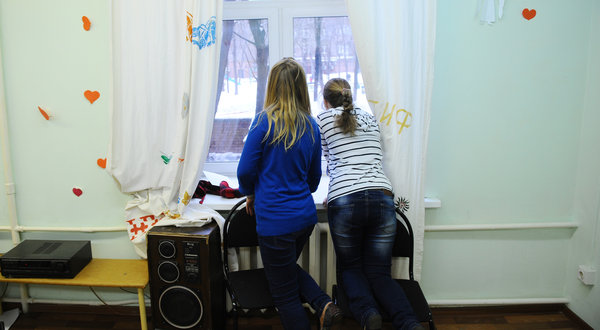A Spate of Teenage Suicides Alarms Russians
A center in Moscow that offers psychological help to teenagers. Experts say more like it are needed.
By GLENN KATES
Published: April 19, 2012
MOSCOW — Russia has been hit with a wave of copycat teenage suicides so pronounced that President Dmitri A. Medvedev felt compelled on Thursday to warn news media outlets against making too much of the deaths, for fear of attracting more imitators.
“It is indeed very alarming and serious, but it does not mean that it is a snowball that will become bigger and bigger every year,” Mr. Medvedev said. “This must be treated extremely gently.”
The spike in teenage suicides began in February, when two 14-year-old girls jumped hand in hand from the 16th-floor roof of an apartment building in suburban Moscow. Afterward, a series of apartment jumps attracted national attention.
Over 24 hours starting on April 9, there were at least six deaths. A girl, 16, jumped from an unfinished hospital in Siberia, while five others hanged themselves: a boy, 15, who died in the city of Perm two days after his mother found him hanging; another 15-year-old, who killed himself on his birthday, in Nizhny Novgorod, a city on the Volga River; teenagers in the northern city of Lomonosov and in Samara; and a 16-year-old murder suspect who used his prison bedsheet to kill himself in Krasnoyarsk.
There have been at least 10 more cases in the past week, including a boy, 11, found hanging under the roof of his house in Krasnodar. Though growing prosperity has tamed Russia’s high rate of adult suicides, the rate of teenage suicides remains three times the world average. Experts blame alcoholism, family dysfunction and other kinds of fallout from the Soviet Union’s collapse, as well as the absence of a mental health structure and social support networks to help troubled young people.
They also agree with Mr. Medvedev that publicity surrounding the suicides — word of which quickly spread on Russian social networks — could encourage copycat acts.
This week, a St. Petersburg newspaper, Smena, criticized the attention being paid to the phenomenon, contending that “while a few adults wrung their hands at the funerals, and others tried to understand the motives of the suicidal teens, some adolescents saw the act as a model to be imitated.”
A report by the United Nations Children’s Fund released late last year said Russia, with 143 million people, ranked third in the world in per capita teenage suicides, trailing two other former Soviet republics, Kazakhstan and Belarus. Around the world, an average of 7 out of every 100,000 teenagers commit suicide every year. In Russia, that number is 22 per 100,000, and in two regions, Tuva and Chukotka, more than 100 per 100,000. Yearly, more than 1,700 Russians between 15 and 19 take their lives, according to the report.
“The reasons for suicide here are many,” said Boris Polozhiy, a psychiatrist at the Serbsky State Scientific Center for Social and Forensic Psychiatry in Moscow. “Social factors, medical factors, psychological factors. So it needs to be solved systematically. All of this work needs to be coordinated.”
“Unfortunately,” he added, “in Russia this system does not yet exist.”
Under Russian law, every school must have at least one psychologist on staff, and there is a national telephone hot line for people to call if they are having suicidal thoughts. But beyond those measures, little effort has been made to address the problem at the federal level.
In February, Pavel Astakhov, Russia’s children’s rights ombudsman, called the situation “catastrophic.”
“It’s a subject which officials, especially bureaucrats, don’t like,” he said. “There is a special department in the Ministry of Health, which is supposed to carry out preventive measures, but so far they only collect the statistical data, information and figures. And the figures are horrible because behind every figure there is the life of a child.”
Lawmakers have focused on the role played by social networks and news media coverage of the year’s cluster of deaths. After public pressure, Vkontakte, Russia’s largest social networking site, began deleting community groups that were giving instructions on methods of committing suicide. Graphic coverage of the acts on state television — vertigo-inducing rooftop views and in at least one instance a shot of a bloodied body covered by a sheet — has largely disappeared.
But Kirill Khlomov, who heads Crossroads, a Moscow center that provides counseling for at-risk teenagers, said that the problems run deeper. “When the media talks about suicide, it always sounds like the answer’s right there,” he said. “Just shut Facebook and then everything will be fine. It is just not so.”
Mr. Khlomov pointed to the vacuum left by Soviet youth organizations like the Young Pioneers, which used to provide social structure for adolescents.
“Little kids still have the attention of their kindergartens, and it’s easier for grownups to handle them, but the teenager is at just the age where he sees the task as to separate from the family,” he said.
On a recent evening, nine boys and girls had come for one of Crossroads’ open-door events. Some painted, while others were happy just to hang out together. But the center, which serves 400 clients a year at no charge to them, is a rarity in Russia.
Mr. Khlomov said Russian parents and teachers all too often dismiss teenagers when they express suicidal thoughts, treating such talk not as a cry for help, but as an attempt at manipulation. This further isolates young people, he said, reinforcing the conviction that no one will ever understand the way they feel.
“When a person commits suicide he forgets about his own life, and his goal is to punish other people,” he said. “But there is nothing afterwards. It’s very specific for teenagers, this feeling of almightiness and infinity.”
© 2012 The New York Times Company
See online: A Spate of Teenage Suicides Alarms Russians

